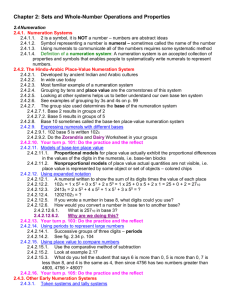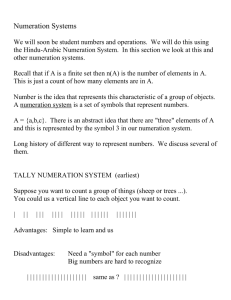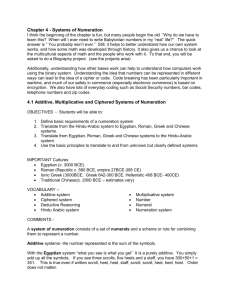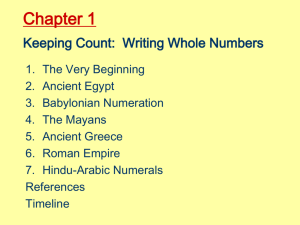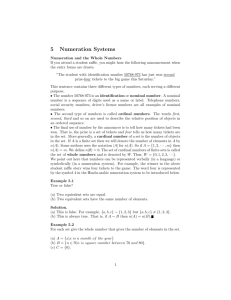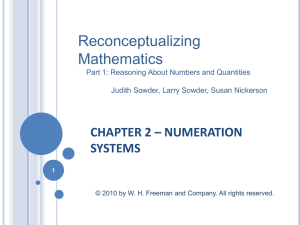Section 2.4
advertisement
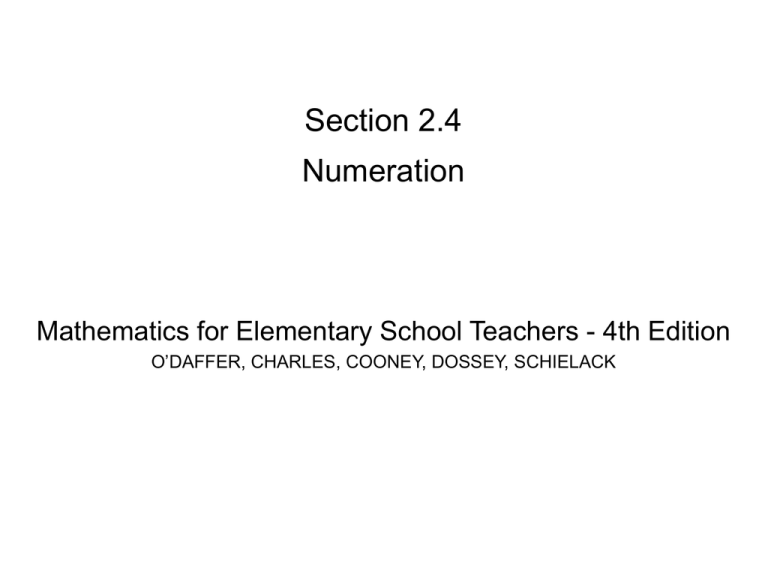
Section 2.4 Numeration Mathematics for Elementary School Teachers - 4th Edition O’DAFFER, CHARLES, COONEY, DOSSEY, SCHIELACK A symbol is different from what it represents The word symbol for cat is different than the actual cat Numeration Systems Just as the written symbol 2 is not itself a number. The written symbol, 2, that represents a number is called a numeral. Here is another familiar numeral (or name) for the number two Definition of Numeration System An accepted collection of properties and symbols that enables people to systematically write numerals to represent numbers. (p. 106, text) Egyptian Numeration System Babylonian Numeration System Roman Numeration System Mayan Numeration System Hindu-Arabic Numeration System Hindu-Arabic Numeration System • Developed by Indian and Arabic cultures • It is our most familiar example of a numeration system • Group by tens: base ten system •10 symbols: 0, 1, 2, 3, 4, 5, 6, 7, 8, 9 • Place value - Yes! The value of the digit is determined by its position in a numeral •Uses a zero in its numeration system Definition of Place Value In a numeration system with place value, the position of a symbol in a numeral determines that symbol’s value in that particular numeral. For example, in the Hindu-Arabic numeral 220, the first 2 represents two hundred and the second 2 represents twenty. Models of Base-Ten Place Value Base-Ten Blocks - proportional model for place value Thousands cube, Hundreds square, Tens stick, Ones cube or block, flat, long, unit text, p. 110 2,345 Models of Base-Ten Place Value Colored-chip model: nonproportional model for place value One Hundred One Thousand Ten One 3,462 chips from text, p. 110 Expressing Numerals with Different Bases: Show why the quantity of tiles shown can be expressed as (a) 27 in base ten and (b)102 in base five, written 102five we can group (a) form groups of 10 these tiles into two 27 groups of ten with 7 tiles left over (b) form groups of 5 102five we can group these tiles into groups of 5 and have enough of these groups of 5 to make one larger group of 5 fives, with 2 tiles left over. No group of 5 is left over, so we need to use a 0 in that position in the numeral: Expressing Numerals with Different Bases: Find the base-ten representation for 1324five 1324five = (1×53) + (3×52) + (2×51) + (4×50) = 1(125) + 3(25) + 2(5) + 4(1) = 125 + 75 + 10 + 4 = 214ten Find the base-ten representation for 344six Find the base-ten representation for 110011two Expressing Numerals with Different Bases: Find the representation of the number 256 in base six 256 - 216 40 -36 4 1(63) + 1(62) + 0(61) + 4(60) 1(216) + 1(36) + 0(6) + 4(1) = 1104six 0 6 =1 1 6 =6 62 = 36 3 6 = 216 64 = 1296 Expressing Numerals with Different Bases: Change 42seven to base five First change to base 10 42seven = 1 4(7 ) + 0 2(7 ) = 30ten Then change to base five 50 = 1 51 = 5 52 = 25 3 5 = 125 30 - 25 5 -5 0 30ten = 1(52) + 1(51) + 0(50) = 110five Expanded Notation: This is a way of writing numbers to show place value, by multiplying each digit in the numeral by its matching place value. Example (using base 10): 1324 = (1×103) + (3×102) + (2×101) + (4×100) or 1324 = (1×1000) + (3×100) + (2×10) + (4×1) Egyptian Numeration System Developed: 3400 B.C.E reed Group by tens New symbols would be needed as system grows No place value heel bone One Ten coiled rope One Hundred lotus flower One Thousand bent finger Ten Thousand burbot fish One Hundred Thousand No use of zero kneeling figure or astonished man One Million Babylonian Numeration System Developed between 3000 and 2000 B.C.E There are two symbols in the Babylonian Numeration System Base 60 Place value one ten Zero came later Write the Hindu-Arabic numerals for the numbers represented by the following numerals from the Babylonian system: 1 42(60 ) + 0 34(60 ) = 2520 + 34 = 2,554 Roman Numeration System Developed between 500 B.C.E and 100 C.E. •Group partially by fives •Would need to add new symbols •Position indicates when to add or subtract •No use of zero Write the Hindu-Arabic numerals for the numbers represented by the Roman Numerals: ⅭⅯⅩⅭⅼⅩ 900 + 90 + 9 = 999 ⅼ (one) Ⅴ (five) Ⅹ (ten) Ⅼ (fifty) Ⅽ (one hundred) Ⅾ (five hundred) Ⅿ(one thousand) Mayan Numeration System Developed between 300 C.E and 900 C.E •Base - mostly by 20 •Number of symbols: 3 •Place value - vertical •Use of Zero Symbols =0 =1 =5 Write the Hindu-Arabic numerals for the numbers represented by the following numerals from the Mayan system: 8(20 ×18) = 2880 6(201) = 120 0(200) = 0 2880 + 120 + 0 = 3000 Summary of Numeration System Characteristics System Grouping Symbols Place Value Use of Zero No No Egyptian By tens Infinitely many possibly needed Babylonia n By sixties Two Yes Not at first Roman Partially by fives Infinitely many possibly needed Position indicates when to add or subtract No Mayan Mostly by twenties Three Yes, Vertically Yes By tens Ten Yes Yes Hindu- The End Section 2.4 Linda Roper
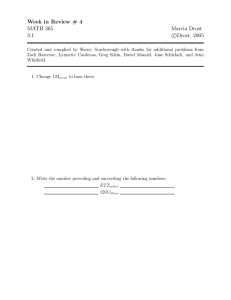
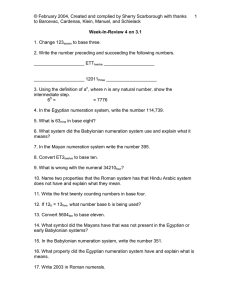
![History_of_Numbers[1] IB Studies conf](http://s2.studylib.net/store/data/009899403_1-c0d85e052ee5d2b9981ad1a48f21cda0-300x300.png)
